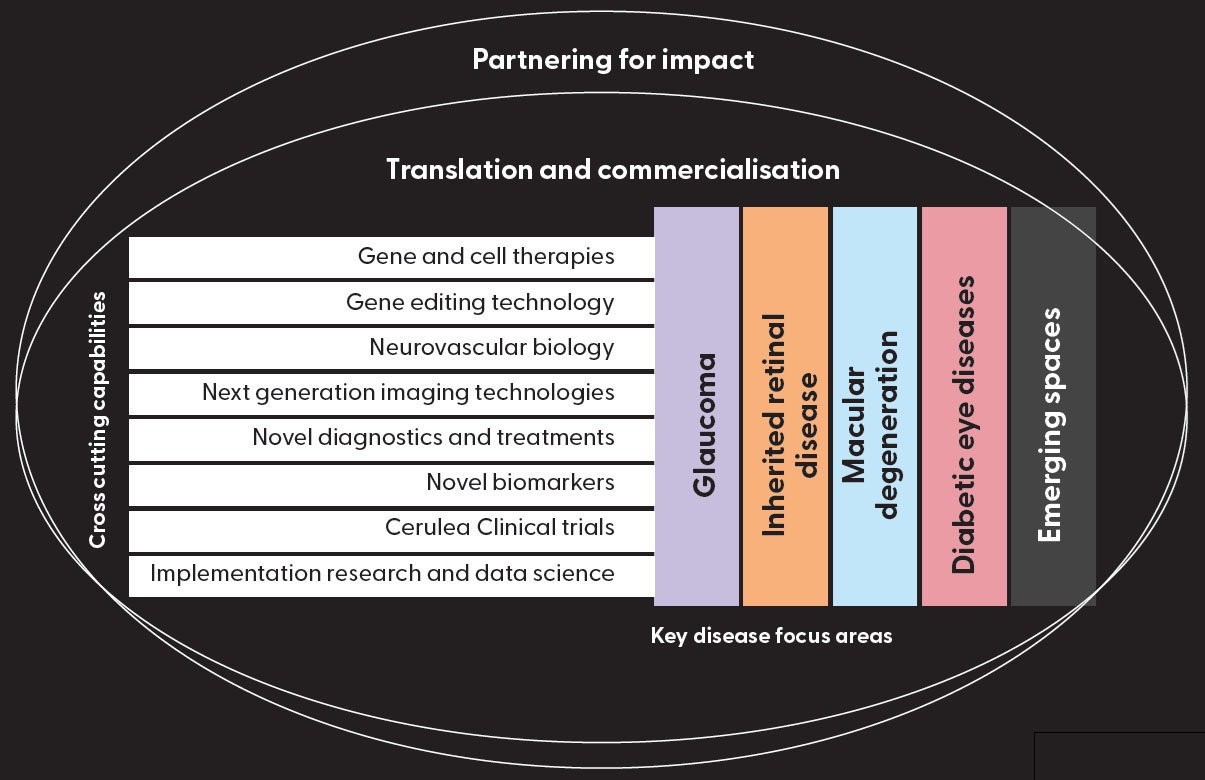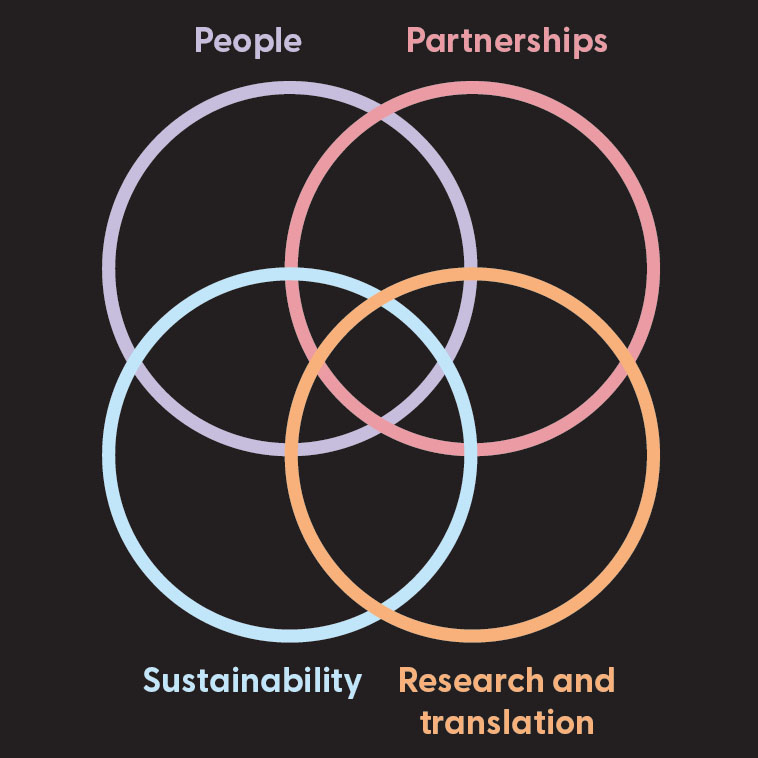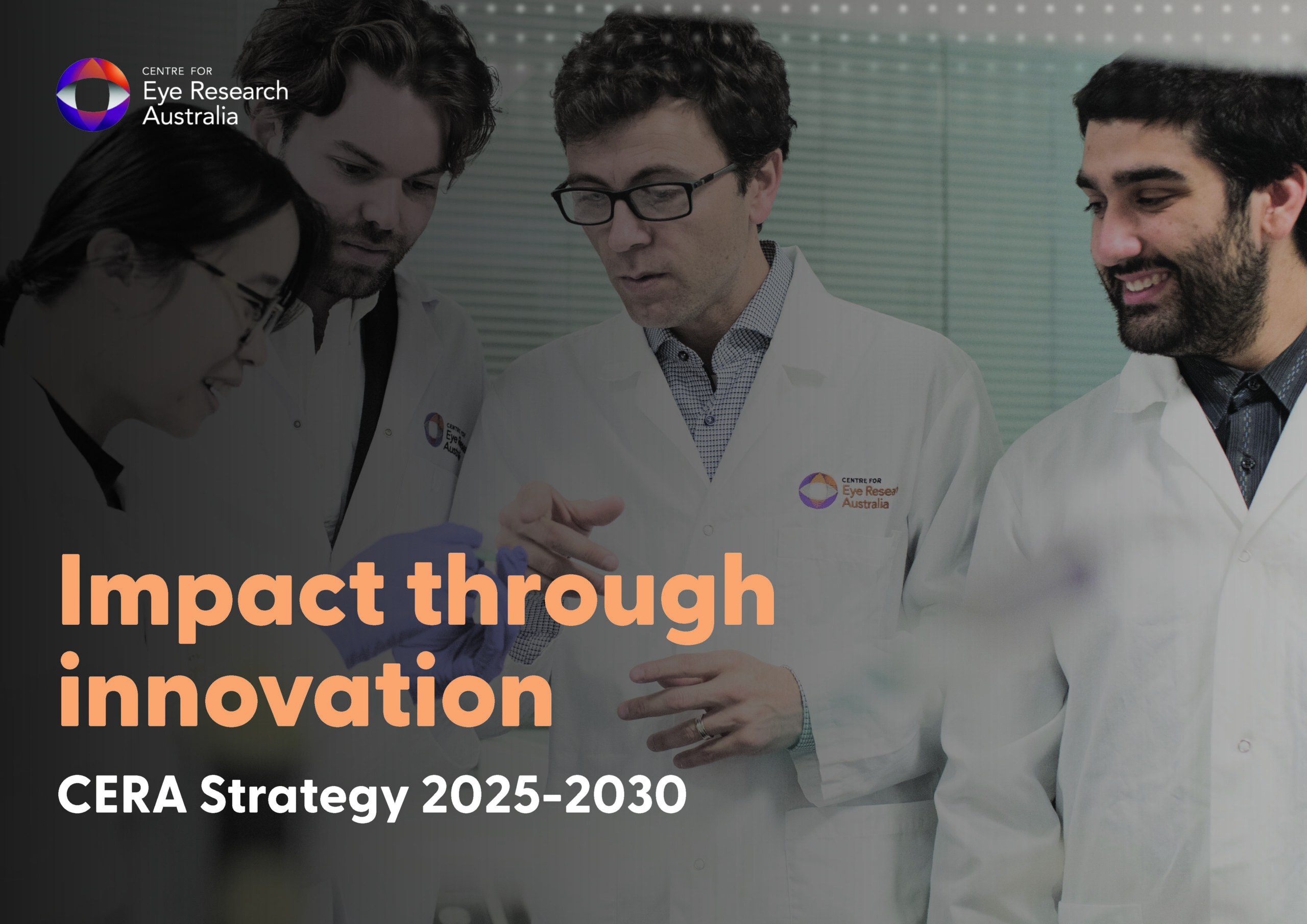CERA Strategy 2025-2030
Impact through innovation
The Centre for Eye Research Australia’s roadmap for the next five years.
The Centre for Eye Research Australia (CERA) acknowledges the Traditional Owners of the land upon which CERA’s sites are located, the Wurundjeri people of the Kulin Nation. We pay our respects to their Elders, past, present and emerging, and recognise their enduring connection to land, waters and culture.
Message from Managing Director Professor Keith Martin
At CERA, our mission has always been clear: to lead the way in transforming the future of eye health and vision.
The past five years has seen CERA transform its infrastructure, capabilities and capacity to undertake translational research from the bench through to patients – both at the bedside and in early intervention – to prevent eye disease. As we look ahead to 2025-30, our focus on impact through innovation will push the boundaries of what’s possible in eye research and patient care. Leveraging the internal capabilities, support functions and infrastructure developed over the previous strategy, CERA will drive a core focus on its research and translation.
CERA will focus its research efforts on the four major eye diseases and causes of vision impairment and blindness: glaucoma, inherited retinal diseases, macular degeneration and diabetic eye diseases, and also seek to support emerging areas such as ocular oncology and others.
We will coalesce our efforts in these areas and seek to build on our strengths in collaboration with our current and new partners aligned with our mission. In addition, we will support other emerging research themes and technologies where we can potentially achieve transformational advances. Examples include ocular oncology, neurovascular biology and data science.
Partnering for impact is at the heart of our vision for the next five years. We aim to become the partner of choice in eye research, deepening our collaborations with consumers, funders, industry, research and academic institutions and clinical partners. By forging stronger, deeper and more dynamic partnerships, we can accelerate the pace of discovery and bring transformative solutions to those who need them most.
Secondly, we will lead in developing early eye disease clinical registries, pioneering a deeper understanding of disease progression. These registries will provide invaluable data and insights that will shape the future of how we diagnose, monitor and treat eye conditions, enabling earlier and more precise interventions.
Finally, we are committed to developing and testing novel eye therapies, harnessing the potential of our world-class facilities and our access to Cerulea Clinical Trials. These advancements will allow us to explore new frontiers in treating and preventing eye disease, ensuring that CERA remains at the cutting edge of clinical innovation.
I am excited about the journey ahead and confident that with impact through innovation, we will make a lasting difference in the lives of millions.
Thank you for your continued support as we embark on this ambitious new chapter.


Keith Martin
Managing Director
About CERA
The Centre for Eye Research Australia is an international leader in eye research with real world impact.
We are an independent Medical Research Institute closely affiliated with the University of Melbourne within the discipline of ophthalmology in the Department of Surgery, Melbourne Medical School and co-located at The Royal Victorian Eye and Ear Hospital.
Our researchers are working to understand how the eye can inform disease prevention, understand the causes of eye disease and improve the diagnosis and treatment of disease.
Our values
- Integrity – We are accountable and honest in the work we do. Credible, ethical and responsible research is our priority.
- Agility – We work with ambition, tenacity, innovation and creativity. We are nimble and responsive in the pursuit of excellence.
- Unity – We work together for the greater good.
- Making a difference – We value collaborating and sharing knowledge with each other and our community to make a real difference in the world. We never waiver from our goal of saving sight and changing people’s lives for the better.
Our vision
A world free from vision loss and blindness.
Our mission
CERA works to eliminate the major eye diseases that cause vision loss and blindness and to reduce their impact on people’s lives.
The Centre for Eye Research Australia is an international leader in eye research with real world impact.
We are an independent Medical Research Institute closely affiliated with the University of Melbourne within the discipline of ophthalmology in the Department of Surgery, Melbourne Medical School and co-located at The Royal Victorian Eye and Ear Hospital.
Our researchers are working to understand how the eye can inform disease prevention, understand the causes of eye disease and improve the diagnosis and treatment of disease.
Our values
- Integrity – We are accountable and honest in the work we do. Credible, ethical and responsible research is our priority.
- Agility – We work with ambition, tenacity, innovation and creativity. We are nimble and responsive in the pursuit of excellence.
- Unity – We work together for the greater good.
- Making a difference – We value collaborating and sharing knowledge with each other and our community to make a real difference in the world. We never waiver from our goal of saving sight and changing people’s lives for the better.
Our vision
A world free from vision loss and blindness.
Our mission
CERA works to eliminate the major eye diseases that cause vision loss and blindness and to reduce their impact on people’s lives.
Impact through innovation
- Early identification of eye disease through clinical registries.
- Mapping disease progression to enable early intervention.
- Development and testing of novel therapies.
- Access to clinical trials for new diagnostics and treatments.
- Improved patient outcomes and quality of life.
Strategy
Partnering for impact
CERA will become the partner of choice for eye research and will deepen relationships with:
- Consumers and patients
- Industry globally and locally to commercialise novel therapies
- Funders and philanthropic partners
- Academic and research Institutions, including the University of Melbourne and aligned research institutes
- Clinical and hospital partners, including the Royal Victorian Eye and Ear Hospital, optometrists and aligned eye clinical services.
Lead in early eye disease intervention
CERA recognises that early intervention is key to preventing vision loss. To achieve this, we will:
- Utilise epidemiology: Employ epidemiological studies to track disease trends and identify risk factors for early detection
- Develop clinical registries: Create and maintain comprehensive registries to collect data on eye diseases,
enabling better understanding of disease progression
- Drive early intervention trials: Use registry data to design and implement clinical trials for early intervention, ensuring access to novel treatment options before vision is threatened.
This proactive approach will help us to preserve sight and improve patient outcomes.
Developing and testing novel eye diagnostics and therapies
CERA will become the place to develop and test new therapies for its key areas of research focus.
Leveraging its world class new facilities, and access to Cerulea Clinical Trials, CERA will be a beacon for the local development and trialing of novel diagnostics, biomarkers and treatments giving patients access to novel therapies and helping clinicians develop more tools to support more effective interventions.
Focus across four key disease areas, whilst nurturing emerging spaces

Emerging spaces
e.g. ocular oncology + corneal diseases + uveitis
Research focus

- Early identification of eye disease through clinical registries.
- Mapping disease progression to enable early intervention.
- Development and testing of novel therapies.
- Access to clinical trials for new diagnostics and treatments.
- Improved patient outcomes and quality of life.
Strategy
Partnering for impact
CERA will become the partner of choice for eye research and will deepen relationships with:
- Consumers and patients
- Industry globally and locally to commercialise novel therapies
- Funders and philanthropic partners
- Academic and research Institutions, including the University of Melbourne and aligned research institutes
- Clinical and hospital partners, including the Royal Victorian Eye and Ear Hospital, optometrists and aligned eye clinical services.
Lead in early eye disease intervention
CERA recognises that early intervention is key to preventing vision loss. To achieve this, we will:
- Utilise epidemiology: Employ epidemiological studies to track disease trends and identify risk factors for early detection
- Develop clinical registries: Create and maintain comprehensive registries to collect data on eye diseases,
enabling better understanding of disease progression - Drive early intervention trials: Use registry data to design and implement clinical trials for early intervention, ensuring access to novel treatment options before vision is threatened.
This proactive approach will help us to preserve sight and improve patient outcomes.
Developing and testing novel eye diagnostics and therapies
CERA will become the place to develop and test new therapies for its key areas of research focus.
Leveraging its world class new facilities, and access to Cerulea Clinical Trials, CERA will be a beacon for the local development and trialing of novel diagnostics, biomarkers and treatments giving patients access to novel therapies and helping clinicians develop more tools to support more effective interventions.
Focus across four key disease areas, whilst nurturing emerging spaces

Emerging spaces
e.g. ocular oncology + corneal diseases + uveitis
Research focus

Our aspiration: measuring success
Over the next five years, we will harness and continue to build CERA’s capabilities to deliver impactful research and to translate it into real world outcomes. Our aspiration is to be the premier eye research institution in the world and the place of choice for ambitious researchers, clinicians and industry partners. Success will be measured across the following four domains.

People
- Attracted and retained a critical mass of world class talent, including early and mid-career researchers.
- High and increasing visibility as a leading research institution with leading researchers.
- Developed a succession plan of the next generation of leaders.
- Continues to develop strong gender diversity and inclusion policies and practices nurturing talent.
Partnerships
- Recognised as a partner of choice and excels in originating, developing and nurturing partnerships.
- Broadened and deepened existing partnerships to accelerate its mission.
- Developed new partnerships locally and globally.
- Deeply engaged with consumers and the community.
- Deeply engaged with the global medtech and pharmaceutical industry sector and capital markets to support commercialisation.
Research and translation
- Sustain and enhance our status as a global leader in vision eye research.
- Has a strong pipeline of novel assets, which are being translated and commercialised.
- Developed specialised and national clinical registries for the key eye diseases to identify and map early disease progression and support early intervention.
Sustainability
- Integrate environmental, social and governance (ESG) principles into decision-making, driving sustainable value through accountability, innovation and stakeholder engagement.
- Increased independence with a strong balance sheet and diversified income mix, increasingly supported by transformational philanthropy and commercial revenue streams including clinical trials, new assets being commercialised and clinical services.
- Monestises infrastructure and assets to support the broader research ecosystem and provide a revenue stream.
Over the next five years, we will harness and continue to build CERA’s capabilities to deliver impactful research and to translate it into real world outcomes. Our aspiration is to be the premier eye research institution in the world and the place of choice for ambitious researchers, clinicians and industry partners. Success will be measured across the following four domains.

People
- Attracted and retained a critical mass of world class talent, including early and mid-career researchers.
- High and increasing visibility as a leading research institution with leading researchers.
- Developed a succession plan of the next generation of leaders.
- Continues to develop strong gender diversity and inclusion policies and practices nurturing talent.
Partnerships
- Recognised as a partner of choice and excels in originating, developing and nurturing partnerships.
- Broadened and deepened existing partnerships to accelerate its mission.
- Developed new partnerships locally and globally.
- Deeply engaged with consumers and the community.
- Deeply engaged with the global medtech and pharmaceutical industry sector and capital markets to support commercialisation.
Research and translation
- Sustain and enhance our status as a global leader in vision eye research.
- Has a strong pipeline of novel assets, which are being translated and commercialised.
- Developed specialised and national clinical registries for the key eye diseases to identify and map early disease progression and support early intervention.
Sustainability
- Integrate environmental, social and governance (ESG) principles into decision-making, driving sustainable value through accountability, innovation and stakeholder engagement.
- Increased independence with a strong balance sheet and diversified income mix, increasingly supported by transformational philanthropy and commercial revenue streams including clinical trials, new assets being commercialised and clinical services.
- Monestises infrastructure and assets to support the broader research ecosystem and provide a revenue stream.


